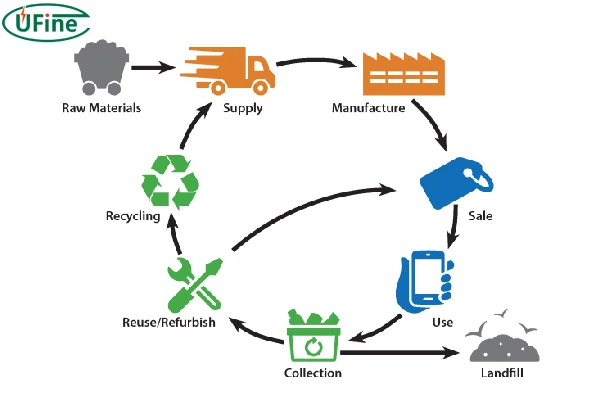Lithium batteries power our gadgets, electric vehicles, and numerous other devices. But what happens when they reach the end of their life? Can they be recycled to create new batteries? Let’s delve into this critical topic and understand the process and benefits of lithium battery recycling.
Part 1. Why recycle lithium batteries?

Lithium batteries are highly recyclable. This is vital because they contain valuable and finite materials such as lithium, cobalt, and nickel. Recycling these materials reduces the need to mine new raw materials, thus conserving natural resources. Additionally, recycling helps mitigate environmental impact. Improper disposal of lithium batteries can lead to soil and water contamination and pose fire and health risks due to their chemical components. By recycling, we not only reclaim valuable resources but also protect our environment.
Part 2. Can all lithium batteries be recycled?
Most, but not all, lithium batteries can be recycled. Generally, lithium-ion (Li-ion) and lithium-polymer (Li-Po) batteries, commonly found in smartphones, laptops, and electric vehicles, are recyclable. However, some older types of lithium batteries or those that are significantly damaged may pose challenges for recycling. It’s important to consult with recycling centers to determine which types of lithium batteries they accept. The recycling process can vary, and certain types may require special handling due to their composition or condition.
| Type | Description |
|---|---|
| Single-use, non-rechargeable batteries |
Made with lithium metal and are commonly used in products such as cameras, watches, remote controls, handheld games and smoke detectors. These batteries may be difficult to distinguish from common alkaline battery sizes, but can also have specialized shapes (e.g., button cells or coin batteries) for specific equipment, such as some types of cameras: look for the word “lithium” on the battery to help identify them. |
| Rechargeable lithium-polymer cells (Li-ion, Li-ion cells) |
Commonly found in cellphones, power tools, digital cameras, laptops, children’s toys, e-cigarettes, small and large appliances, tablets and e-readers. Some Li-ion batteries can be removed easily from the products they power, others cannot. |
Part 3. What are lithium batteries made of?
To understand how lithium batteries are recycled, it’s useful to know their structure:
- Cathode: Contains lithium, cobalt, manganese, or nickel.
- Anode: Typically made of graphite.
- Electrolyte: A lithium salt dissolved in an organic solvent.
- Separator: A porous polymer that prevents short circuits by separating the cathode and anode.
These components, particularly the metals, are valuable and can be extracted and reused in the production of new batteries.
Part 4. How are lithium batteries recycled?
The recycling process for lithium batteries is complex and involves several stages:
- Collection: Batteries are collected from consumers, businesses, and recycling centers.
- Sorting: Batteries are sorted by type and condition to determine the appropriate recycling process.
- Discharge: Batteries are safely discharged to eliminate any remaining charge, reducing the risk of accidents.
- Shredding: Batteries are shredded into smaller pieces, allowing for easier material separation.
- Separation: The shredded material undergoes mechanical and chemical processes to separate the components. This often involves techniques like sieving, magnetic separation, and flotation.
- Extraction: Valuable materials, such as lithium, cobalt, and nickel, are extracted through hydrometallurgical or pyrometallurgical methods. These materials are then refined for reuse.
Part 5. Who recycles lithium batteries?
The recycling of lithium batteries is handled by specialized companies and facilities equipped to manage the complex and hazardous process. These organizations employ advanced technologies and adhere to strict safety and environmental regulations to ensure effective recycling.
Prominent Recycling Companies:
- Umicore: A global materials technology company leader in battery recycling. Umicore operates large-scale facilities capable of processing various types of lithium batteries, extracting valuable metals, and reducing environmental impact.
- Redwood Materials: Founded by a former Tesla executive, Redwood Materials focuses on creating a circular supply chain for batteries. They recycle end-of-life batteries and reuse the extracted materials in new batteries.
- Li-Cycle: This company specializes in the recovery of critical materials from lithium-ion batteries. Their proprietary process allows them to recover up to 95% of all battery materials, including lithium, cobalt, and nickel.
Take-Back Programs:
Many electronics manufacturers and retailers offer take-back programs for used batteries. For example, Apple has a robust recycling program where customers can return old devices, and the company ensures proper recycling. Tesla also has a program for recycling batteries from its electric vehicles.
Retailers like Best Buy and Staples provide drop-off points for consumers to recycle used batteries, partnering with recycling firms to manage the process.
Government and Municipal Programs:
Various government and municipal programs encourage battery recycling by providing designated collection points and organizing recycling drives. These programs often collaborate with certified recycling companies to handle the collected batteries.
These initiatives collectively contribute to a more sustainable and environmentally friendly approach to managing lithium battery waste.
Part 6. Can lithium batteries be recycled to make new batteries?
Lithium batteries can indeed be recycled to make new batteries, and this process is becoming increasingly efficient and widespread. The key lies in recovering and purifying the essential materials used in battery production.
Materials Recovery:
The recycling process focuses on extracting valuable metals such as lithium, cobalt, nickel, and manganese from used batteries. These metals are critical components in the production of new batteries.
After extraction, the materials undergo a refining process to remove impurities and restore them to a state suitable for new battery production. This often involves advanced chemical and physical treatment techniques to ensure high purity levels.
Manufacturing New Batteries:
Once purified, the recycled materials are reintroduced into the battery manufacturing process. They are used to create new cathodes, anodes, and other components essential for battery function.
This closed-loop system not only reduces the need for new raw materials but also lowers the environmental footprint associated with mining and processing virgin materials.
Technological Advancements:
Technological advancements in recycling methods are continually improving the efficiency and effectiveness of material recovery. Innovations such as direct recycling, which reuses battery components without breaking them down into raw materials, are emerging as promising methods.
By recycling lithium batteries into new ones, we are conserving resources and promoting sustainability in the battery industry. This circular approach is essential for meeting the growing demand for batteries while minimizing environmental impact.
Part 7. Can I buy new batteries made from recycled lithium batteries?
Consumers can purchase new batteries made from recycled lithium batteries, and this option is becoming more accessible as the industry advances.
1. Availability in the Market:
Several companies are now offering batteries that incorporate recycled materials. For instance, Redwood Materials partners with battery manufacturers to supply them with recycled metals, which are then used in new battery production.
Tesla is also working towards using recycled materials in their batteries, promoting a sustainable lifecycle for their electric vehicles.
2. Performance and Reliability:
Batteries made from recycled materials are designed to meet the same performance and safety standards as those made from virgin materials. The rigorous processes involved in recycling and refining ensure that the quality of the recycled components matches or even exceeds industry standards.
These batteries offer the same reliability, longevity, and efficiency, making them a viable and sustainable alternative to traditional batteries.
3. Consumer Benefits:
By choosing batteries made from recycled materials, consumers can support environmental sustainability. This choice helps reduce the environmental impact of battery production and supports the circular economy.
Additionally, as the demand for sustainable products grows, the availability and variety of these batteries are expected to increase, providing consumers with more options.
Part 8. Lithium Battery Recycling Safety
- Safety is a crucial aspect of lithium battery recycling. Here are some essential tips to ensure safe handling:
- Do not throw batteries in the trash: They can cause fires and release harmful chemicals.
- Store used batteries in a cool, dry place: This prevents deterioration and reduces the risk of fire.
- Tape the terminals: This prevents short circuits and accidental discharges.
- Bring batteries to designated recycling centers: Ensure they are handled by professionals.
Recycling lithium batteries is possible and essential for environmental conservation and resource management. By supporting recycling efforts and using batteries made from recycled materials, we can make a significant positive impact on our planet.
Related Tags:
More Articles

Top 10 Recommended Bluetooth Headphones Battery
You must find the best Bluetooth headphone battery to ensure long-lasting usage. Check out our list of the best Bluetooth headphone batteries!
Top 10 Recommended Lithium Ion Forklift Battery
Finding ideal lithium-ion forklift batteries is challenging in this industry. But we have made a quick list of the best options!
Is the Anode Positive or Negative in Different Battery Types?
Is the anode positive or negative? This article explores the charge of anodes in different batteries and their crucial role in powering devices.
Is Cathode Positive or Negative?
Is the cathode positive or negative? This article explores the role, characteristics, and functions of cathodes in various electrochemical cells.
Metal Air Battery Vs. Lithium Metal Battery: A Comprehensive Analysis
Metal-air and lithium metal batteries could transform energy storage. This article compares their mechanisms, benefits, drawbacks, and applications.




